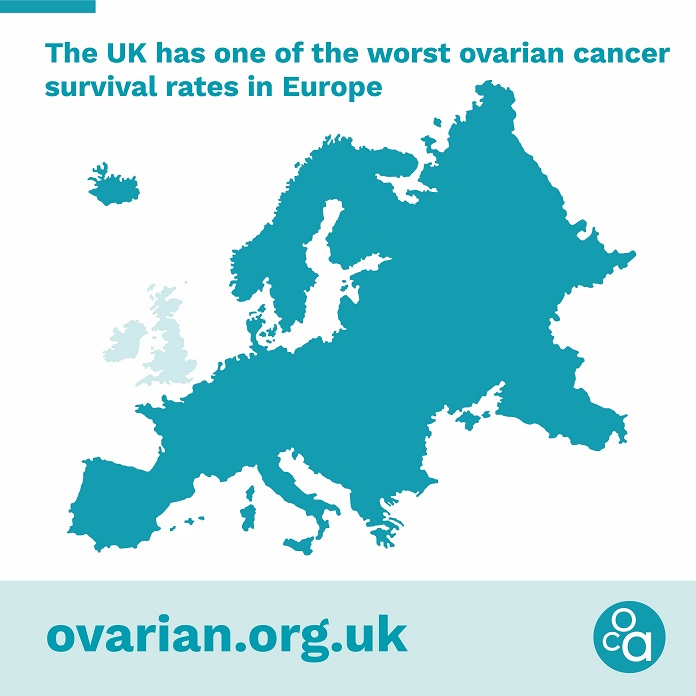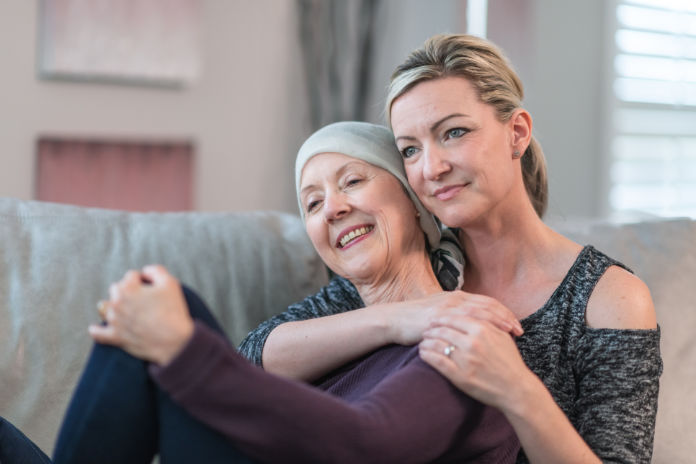Ovarian cancer has a survival rate for 10 or more years of only around 35%, and around 11% of cases in the UK are preventable. So what is ovarian cancer, and what are the symptoms and risk factors?

What is ovarian cancer?
Ovarian cancer is the cancer of the ovaries – the part of the female productive system that produces eggs. Though it’s not always possible to say why ovarian cancer occurs, there are some known risk-factors, including genes. Women with the BRCA1/2 gene mutation can be at significantly greater risk, or if two or more close blood relatives have had the disease under the age of 50.
Women who started their periods particularly early or started menopause quite late, plus those who’ve never carried children, may be more likely to develop ovarian cancer too, along with those with a history of endometriosis. Research also shows using oestrogen-only or combined HRT (hormone replacement therapy) can increase a woman’s risk of ovarian cancer. Only 1% of cases are linked to HRT but it’s a good idea to fully discuss all the pros and cons with your doctor.
It’s not a ‘silent’ killer
Ovarian cancer is often falsely dubbed ‘the silent killer’ as people often believe it has no symptoms. The reality is that many women have been living with symptoms long before they go to the doctor and get a diagnosis.
The symptoms are subtle
That being said, the symptoms of ovarian cancer are often less obvious than breast cancer. The four most common signs are persistent stomach pain, persistent bloating or increased stomach size, difficulty eating or feeling full quickly and needing to wee more frequently.
As everyone has likely experienced these symptoms at some point or another, it can be difficult to tell if it’s a sign of ovarian cancer. The key is in persistence and noticing when the symptoms don’t go away.
It affects young women too
Post-menopausal women who haven’t had any children, or are infertile, are most at risk of developing the disease. However, it is also possible for younger women to develop it. Ovarian Cancer Action reports that while some 80% of the women diagnosed each year are 50 plus, that leaves 1 in 5 who are younger.
A cervical smear won’t detect it
According to Ovarian Cancer Action, one in four women mistakenly think that a cervical smear can detect ovarian cancer. The truth is that there is no test for ovarian cancer, which is why women need to be diligent about catching the symptoms early.
If you’re concerned, downloading a symptom tracker from the app store can help you to record how often you’re urinating, how often you experience stomach pain and bloating, and any other changes that might be important for your doctor to know.
It’s not the same as cervical cancer
There are lots of different gynaecological cancers, including cervical, ovarian, uterine, vaginal and vulvar. Each of these cancers has different signs and symptoms.
It’s more common than you think
According to Cancer Research UK, each year in the UK there are approximately 7,400 cases of ovarian cancer – this is roughly 142 women each week. If you suspect you’re displaying the symptoms of ovarian cancer, speak to your GP.
7 common symptoms of ovarian cancer
Being aware of the symptoms is vital for all women – and GPs and doctors – as early diagnosis is the best way to ensure ovarian cancer can be successfully treated.
Part of the problem is, because of their subtle nature, Jo Stanford, cancer prevention officer at Ovarian Cancer Action, says the symptoms are often mistaken for other conditions. These include irritable bowel syndrome (IBS), as well as ovarian cysts and polycystic ovaries.
Of course – often the symptoms are down to something more common and less sinister, like IBS, but it’s important to get them checked out, just in case. Here are seven potential ovarian cancer symptoms you should never ignore…
1. Persistent bloating
This is a common symptom of ovarian cancer. Bloating might be accompanied by pain or an increased need to pass wind, and isn’t affected by food and medication. However, it’s often mistaken for problems such as IBS, food allergies and gastric infections.
Sometimes the bloating may be visible, and in advanced ovarian cancer, a football-sized lump may be seen in women’s abdomens – it might even look like a pregnancy bump.

2. Persistent abdominal pain
This pain will be around the tummy, abdomen and/or pelvic area, and will be constant rather than intermittent, with no obvious explanation. Again, this is often mistaken for conditions such as IBS, gastric infections and menstrual cramps.
3. Needing to urinate more frequently
A noticeable increase in how often a woman needs to wee is also a common symptom, as well as noticing that you need to take multiple trips to the toilet during the night.
There will be no obvious reason for this increase, such as drinking significantly more fluid than usual. This symptom can often be misdiagnosed as a urinary tract infection.
4. Difficulty eating or feeling full more quickly
Eating noticeably less than usual, despite feeling hungry, is another key sign to look out for. Women may sit down to eat a meal as normal but feel full much quicker than usual, often leaving large amounts of food.
This may sometimes be accompanied by a complete loss of appetite, although not always.
5. Changes in bowel habits
This could be going to the toilet a lot more often, or much less frequently than usual. You may not necessarily experience extreme constipation or diarrhoea either.
There will be no obvious explanation for this change, such as a change of diet or medication use.
6. Extreme tiredness or unexplained weight loss
Look out for a constant feeling of being extremely tired, despite there being no change in lifestyle, sleep patterns, diet or medications.
Losing a noticeable amount of weight over a short period of time can also be a red flag, particularly if you haven’t made any changes to diet, lifestyle or the amount of food consumed.
7. Back pain
Pain in the lower back, often mistaken for a pulled muscle or strain, can sometimes be caused by ovarian cancer. There will be no obvious reason for the pain and it will persist, rather than improve.

If you experience any of these symptoms, have a chat with your doctor. Ovarian Cancer Action also recommends women keep a record of their symptoms to take with them to the GP. The charity has also created a ‘symptoms diary’ which women can download from their website to help make recording symptoms easier. Visit ovarian.org.uk.
Ovarian cancer risk factors
Here, Adeola Olaitan, consultant gynaecological oncologist at The Harley Street Clinic, part of HCA Healthcare UK, highlights seven key ovarian cancer risk factors to keep in mind.
1. Age
“As with most illness and cancers in general, age can increase your chances of developing ovarian cancer. Epithelial ovarian cancer, the most common type, occurs most frequently in women between the ages of 75 and 79, but the risk increases substantially after the age of 50.”
2. Genetics
“Most ovarian cancers occur by chance, but in a small minority, it is because of an inherited predisposition. This accounts for around 5-15% of all cases diagnosed. The genes that increase the risk of this type of cancer include the BRCA1 and BRCA2 – faults in these genes are also linked to breast cancer.

“It’s important for women to know that having relatives who’ve had ovarian cancer does not necessarily mean they will too develop the cancer. Their relative’s cancer might have occurred by chance. However, women with a close relative (father, mother, brother or sister) who have been diagnosed with breast, ovarian or bowel cancer are more at risk of ovarian cancer compared to those without any family history.
“Women at risk should be screened for a faulty gene, as they can then be advised about their cancer risk and measures that can be taken to reduce it.”
3. Previous cancer
“Women may have an increased risk of ovarian cancer if they have had certain cancers in the past. This is particularly the case for breast cancer and bowel cancer.
“The increased risk is likely to be linked to an inherited faulty gene, which is associated with a condition called Lynch syndrome.”
4. Hormone Replacement Therapy (HRT)
“Using Hormone Replacement Therapy after the menopause can increase your risk of ovarian cancer. HRT is linked to around 4 in every 100 cases of ovarian cancer in the UK.
“It is important that women know that this is a very small increased risk. Therefore, if HRT is alleviating potentially debilitating menopausal symptoms, then it is not worth being overly concerned about.
“I would always recommend that women should speak to their GP if they are concerned that they might have an inherited predisposition to ovarian cancer so they can receive specific advice.”
5. Smoking
“Smoking increases the risk of most illnesses, and cancers in particular. This is no different for ovarian cancer. If someone has smoked throughout their life, this will increase their risk of cancerous mutations occurring in the ovaries.”
6. Obesity
“Being overweight increases the risk of ovarian cancer. Therefore, it is important for women as they get older to try to maintain a healthy weight to mitigate against this risk.”
7. Other medical conditions
“Research has found that for women with endometriosis or diabetes may have an increased risk of developing ovarian cancer.”
You may also be interested in…































































